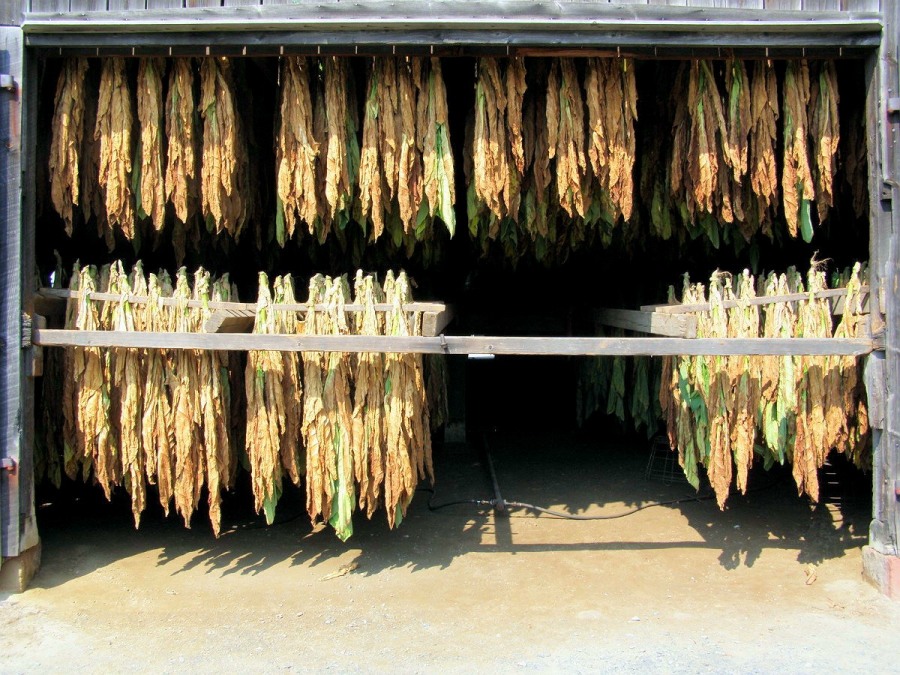
Drying Tobacco, South Windsor – Jerry Dougherty
Connecticut’s agricultural roots date back to the crop gardens planted by indigenous peoples who cultivated such staples as the Three Sisters (maize, beans, and squash), sunflowers, and Jerusalem artichokes. European settlers brought their own land-use practices, such as clearing large tracts of land for crops and grazing livestock, and learned new techniques from the region’s Natives. By the late 18th century farming was an economic mainstay for most residents, but by the middle of the 19th century the rise of industry changed the state’s agrarian landscape to an industrial one. Farmland acreage and the number of farms in the state steadily declined well into the 21st century, with recent tallies showing fewer than 5,000 farms. There is, however, a renewed interest in local farming and today’s small farms produce dairy, eggs, tobacco, fruits, and vegetables that contribute to the state’s economy.
Featured
In 1760, this Killingworth minister and farmer published the first agricultural advice book in the British American colonies. …[more]
Learn More
58529
3DECCFFA
1
apsa
50
default
8100
https://connecticuthistory.org/wp-content/plugins/zotpress/
%7B%22status%22%3A%22success%22%2C%22updateneeded%22%3Afalse%2C%22instance%22%3Afalse%2C%22meta%22%3A%7B%22request_last%22%3A0%2C%22request_next%22%3A0%2C%22used_cache%22%3Atrue%7D%2C%22data%22%3A%5B%7B%22key%22%3A%22MJ7Q7RDF%22%2C%22library%22%3A%7B%22id%22%3A58529%7D%2C%22meta%22%3A%7B%22lastModifiedByUser%22%3A%7B%22id%22%3A14399323%2C%22username%22%3A%22kquotap%22%2C%22name%22%3A%22%22%2C%22links%22%3A%7B%22alternate%22%3A%7B%22href%22%3A%22https%3A%5C%2F%5C%2Fwww.zotero.org%5C%2Fkquotap%22%2C%22type%22%3A%22text%5C%2Fhtml%22%7D%7D%7D%2C%22parsedDate%22%3A%222017%22%2C%22numChildren%22%3A0%7D%2C%22bib%22%3A%22%3Cdiv%20class%3D%5C%22csl-bib-body%5C%22%20style%3D%5C%22line-height%3A%201.35%3B%20padding-left%3A%201em%3B%20text-indent%3A-1em%3B%5C%22%3E%5Cn%20%20%3Cdiv%20class%3D%5C%22csl-entry%5C%22%3E%26%23x201C%3BThe%20Luddy%5C%2FTaylor%20Connecticut%20Valley%20Tobacco%20Museum.%26%23x201D%3B%202017.%20%3Ca%20class%3D%27zp-ItemURL%27%20href%3D%27http%3A%5C%2F%5C%2Fwww.tobaccohistsoc.org%5C%2F%27%3Ehttp%3A%5C%2F%5C%2Fwww.tobaccohistsoc.org%5C%2F%3C%5C%2Fa%3E.%3C%5C%2Fdiv%3E%5Cn%3C%5C%2Fdiv%3E%22%2C%22data%22%3A%7B%22itemType%22%3A%22webpage%22%2C%22title%22%3A%22The%20Luddy%5C%2FTaylor%20Connecticut%20Valley%20Tobacco%20Museum%22%2C%22creators%22%3A%5B%5D%2C%22abstractNote%22%3A%22%22%2C%22date%22%3A%222017%22%2C%22url%22%3A%22http%3A%5C%2F%5C%2Fwww.tobaccohistsoc.org%5C%2F%22%2C%22language%22%3A%22%22%2C%22collections%22%3A%5B%223DECCFFA%22%2C%22EV6SMFHW%22%2C%22A3KGDPPZ%22%2C%22RSQV5R82%22%2C%22MKX7MGG7%22%2C%22FHWNDKHJ%22%2C%22X8PAVJ37%22%2C%225882U9Z3%22%5D%2C%22dateModified%22%3A%222023-09-11T19%3A17%3A46Z%22%7D%7D%2C%7B%22key%22%3A%229FSZCGZX%22%2C%22library%22%3A%7B%22id%22%3A58529%7D%2C%22meta%22%3A%7B%22lastModifiedByUser%22%3A%7B%22id%22%3A14399323%2C%22username%22%3A%22kquotap%22%2C%22name%22%3A%22%22%2C%22links%22%3A%7B%22alternate%22%3A%7B%22href%22%3A%22https%3A%5C%2F%5C%2Fwww.zotero.org%5C%2Fkquotap%22%2C%22type%22%3A%22text%5C%2Fhtml%22%7D%7D%7D%2C%22parsedDate%22%3A%222016%22%2C%22numChildren%22%3A1%7D%2C%22bib%22%3A%22%3Cdiv%20class%3D%5C%22csl-bib-body%5C%22%20style%3D%5C%22line-height%3A%201.35%3B%20padding-left%3A%201em%3B%20text-indent%3A-1em%3B%5C%22%3E%5Cn%20%20%3Cdiv%20class%3D%5C%22csl-entry%5C%22%3E%26%23x201C%3BColton-Hayes%20Tobacco%20Barn%20%26amp%3B%20Museum.%26%23x201D%3B%202016.%20%3Ci%3ESalmon%20Brook%20Historical%20Society%3C%5C%2Fi%3E.%20%3Ca%20class%3D%27zp-ItemURL%27%20href%3D%27https%3A%5C%2F%5C%2Fwww.salmonbrookhistoricalsociety.com%5C%2Fgranby-views%27%3Ehttps%3A%5C%2F%5C%2Fwww.salmonbrookhistoricalsociety.com%5C%2Fgranby-views%3C%5C%2Fa%3E%20%28September%2026%2C%202016%29.%3C%5C%2Fdiv%3E%5Cn%3C%5C%2Fdiv%3E%22%2C%22data%22%3A%7B%22itemType%22%3A%22webpage%22%2C%22title%22%3A%22Colton-Hayes%20Tobacco%20Barn%20%26%20Museum%22%2C%22creators%22%3A%5B%5D%2C%22abstractNote%22%3A%22%22%2C%22date%22%3A%222016%22%2C%22url%22%3A%22https%3A%5C%2F%5C%2Fwww.salmonbrookhistoricalsociety.com%5C%2Fgranby-views%22%2C%22language%22%3A%22%22%2C%22collections%22%3A%5B%223DECCFFA%22%2C%22EV6SMFHW%22%2C%22X5MC4J95%22%2C%22JSXT5TRJ%22%5D%2C%22dateModified%22%3A%222023-09-11T19%3A16%3A48Z%22%7D%7D%2C%7B%22key%22%3A%22DFIEXEFC%22%2C%22library%22%3A%7B%22id%22%3A58529%7D%2C%22meta%22%3A%7B%22lastModifiedByUser%22%3A%7B%22id%22%3A14399323%2C%22username%22%3A%22kquotap%22%2C%22name%22%3A%22%22%2C%22links%22%3A%7B%22alternate%22%3A%7B%22href%22%3A%22https%3A%5C%2F%5C%2Fwww.zotero.org%5C%2Fkquotap%22%2C%22type%22%3A%22text%5C%2Fhtml%22%7D%7D%7D%2C%22parsedDate%22%3A%222017%22%2C%22numChildren%22%3A1%7D%2C%22bib%22%3A%22%3Cdiv%20class%3D%5C%22csl-bib-body%5C%22%20style%3D%5C%22line-height%3A%201.35%3B%20padding-left%3A%201em%3B%20text-indent%3A-1em%3B%5C%22%3E%5Cn%20%20%3Cdiv%20class%3D%5C%22csl-entry%5C%22%3E%26%23x201C%3BA%20Guide%20to%20the%20Connecticut%20Valley%20Tobacco%20Growers%20Association%20Records.%26%23x201D%3B%202017.%20%3Ci%3EUniversity%20of%20Connecticut%2C%20Archives%20%26amp%3B%20Special%20Collections%20at%20the%20Thomas%20J.%20Dodd%20Research%20Center%3C%5C%2Fi%3E.%20%3Ca%20class%3D%27zp-ItemURL%27%20href%3D%27http%3A%5C%2F%5C%2Farchives.lib.uconn.edu%5C%2Fislandora%5C%2Fobject%5C%2F20002%253A860138049%3Fsolr_nav%5Bid%5D%3D174578ed0d4f5763c380%26solr_nav%5Bpage%5D%3D0%26solr_nav%5Boffset%5D%3D0%27%3Ehttp%3A%5C%2F%5C%2Farchives.lib.uconn.edu%5C%2Fislandora%5C%2Fobject%5C%2F20002%253A860138049%3Fsolr_nav%5Bid%5D%3D174578ed0d4f5763c380%26solr_nav%5Bpage%5D%3D0%26solr_nav%5Boffset%5D%3D0%3C%5C%2Fa%3E%20%28September%2018%2C%202013%29.%3C%5C%2Fdiv%3E%5Cn%3C%5C%2Fdiv%3E%22%2C%22data%22%3A%7B%22itemType%22%3A%22webpage%22%2C%22title%22%3A%22A%20Guide%20to%20the%20Connecticut%20Valley%20Tobacco%20Growers%20Association%20Records%22%2C%22creators%22%3A%5B%5D%2C%22abstractNote%22%3A%22%22%2C%22date%22%3A%222017%22%2C%22url%22%3A%22http%3A%5C%2F%5C%2Farchives.lib.uconn.edu%5C%2Fislandora%5C%2Fobject%5C%2F20002%253A860138049%3Fsolr_nav%5Bid%5D%3D174578ed0d4f5763c380%26solr_nav%5Bpage%5D%3D0%26solr_nav%5Boffset%5D%3D0%22%2C%22language%22%3A%22%22%2C%22collections%22%3A%5B%223DECCFFA%22%2C%226WIB6TCK%22%2C%22C92XAIFZ%22%2C%22PGA9CUDD%22%5D%2C%22dateModified%22%3A%222017-04-13T14%3A40%3A33Z%22%7D%7D%2C%7B%22key%22%3A%227MZESRQU%22%2C%22library%22%3A%7B%22id%22%3A58529%7D%2C%22meta%22%3A%7B%22lastModifiedByUser%22%3A%7B%22id%22%3A14399323%2C%22username%22%3A%22kquotap%22%2C%22name%22%3A%22%22%2C%22links%22%3A%7B%22alternate%22%3A%7B%22href%22%3A%22https%3A%5C%2F%5C%2Fwww.zotero.org%5C%2Fkquotap%22%2C%22type%22%3A%22text%5C%2Fhtml%22%7D%7D%7D%2C%22creatorSummary%22%3A%22Simon%22%2C%22numChildren%22%3A0%7D%2C%22bib%22%3A%22%3Cdiv%20class%3D%5C%22csl-bib-body%5C%22%20style%3D%5C%22line-height%3A%201.35%3B%20padding-left%3A%201em%3B%20text-indent%3A-1em%3B%5C%22%3E%5Cn%20%20%3Cdiv%20class%3D%5C%22csl-entry%5C%22%3ESimon%2C%20Kenneth%20A.%20%3Ci%3EWorking%20the%20Land%20the%20Story%20of%20Connecticut%20Agriculture%20-%20Help%20Support%20Connecticut%20Humanities%20and%20Click%20the%20Link%20to%20Purchase%3C%5C%2Fi%3E.%20Moodus%2C%20CT%3A%20SimonPure%20Productions.%20%3Ca%20class%3D%27zp-ItemURL%27%20href%3D%27https%3A%5C%2F%5C%2Fconnecticuthistory.org%5C%2Foldies-but-goodies-order-dvds-from-the-vaults-of-the-connecticut-humanities%5C%2F%27%3Ehttps%3A%5C%2F%5C%2Fconnecticuthistory.org%5C%2Foldies-but-goodies-order-dvds-from-the-vaults-of-the-connecticut-humanities%5C%2F%3C%5C%2Fa%3E.%3C%5C%2Fdiv%3E%5Cn%3C%5C%2Fdiv%3E%22%2C%22data%22%3A%7B%22itemType%22%3A%22videoRecording%22%2C%22title%22%3A%22Working%20the%20Land%20the%20Story%20of%20Connecticut%20Agriculture%20-%20Help%20Support%20Connecticut%20Humanities%20and%20Click%20the%20Link%20to%20Purchase%22%2C%22creators%22%3A%5B%7B%22creatorType%22%3A%22director%22%2C%22firstName%22%3A%22Kenneth%20A.%22%2C%22lastName%22%3A%22Simon%22%7D%2C%7B%22creatorType%22%3A%22contributor%22%2C%22firstName%22%3A%22Sam%22%2C%22lastName%22%3A%22Waterston%22%7D%2C%7B%22creatorType%22%3A%22producer%22%2C%22firstName%22%3A%22%22%2C%22lastName%22%3A%22SimonPure%20Productions%22%7D%2C%7B%22creatorType%22%3A%22producer%22%2C%22firstName%22%3A%22%22%2C%22lastName%22%3A%22Connecticut%20Humanities%20Council%22%7D%5D%2C%22abstractNote%22%3A%22%22%2C%22videoRecordingFormat%22%3A%22%22%2C%22studio%22%3A%22SimonPure%20Productions%22%2C%22date%22%3A%22%22%2C%22runningTime%22%3A%22%22%2C%22language%22%3A%22English%22%2C%22ISBN%22%3A%22%22%2C%22url%22%3A%22https%3A%5C%2F%5C%2Fconnecticuthistory.org%5C%2Foldies-but-goodies-order-dvds-from-the-vaults-of-the-connecticut-humanities%5C%2F%22%2C%22collections%22%3A%5B%223DECCFFA%22%2C%224ZUKDQD9%22%5D%2C%22dateModified%22%3A%222017-04-13T14%3A33%3A29Z%22%7D%7D%2C%7B%22key%22%3A%22AKDR8J7A%22%2C%22library%22%3A%7B%22id%22%3A58529%7D%2C%22meta%22%3A%7B%22lastModifiedByUser%22%3A%7B%22id%22%3A14399323%2C%22username%22%3A%22kquotap%22%2C%22name%22%3A%22%22%2C%22links%22%3A%7B%22alternate%22%3A%7B%22href%22%3A%22https%3A%5C%2F%5C%2Fwww.zotero.org%5C%2Fkquotap%22%2C%22type%22%3A%22text%5C%2Fhtml%22%7D%7D%7D%2C%22parsedDate%22%3A%222017%22%2C%22numChildren%22%3A1%7D%2C%22bib%22%3A%22%3Cdiv%20class%3D%5C%22csl-bib-body%5C%22%20style%3D%5C%22line-height%3A%201.35%3B%20padding-left%3A%201em%3B%20text-indent%3A-1em%3B%5C%22%3E%5Cn%20%20%3Cdiv%20class%3D%5C%22csl-entry%5C%22%3E%26%23x201C%3BThe%20Connecticut%20Antique%20Machinery%20Association%20Museum.%26%23x201D%3B%202017.%20%3Ca%20class%3D%27zp-ItemURL%27%20href%3D%27http%3A%5C%2F%5C%2Fwww.ctamachinery.com%5C%2F%27%3Ehttp%3A%5C%2F%5C%2Fwww.ctamachinery.com%5C%2F%3C%5C%2Fa%3E%20%28September%2021%2C%202012%29.%3C%5C%2Fdiv%3E%5Cn%3C%5C%2Fdiv%3E%22%2C%22data%22%3A%7B%22itemType%22%3A%22webpage%22%2C%22title%22%3A%22The%20Connecticut%20Antique%20Machinery%20Association%20Museum%22%2C%22creators%22%3A%5B%5D%2C%22abstractNote%22%3A%22%22%2C%22date%22%3A%222017%22%2C%22url%22%3A%22http%3A%5C%2F%5C%2Fwww.ctamachinery.com%5C%2F%22%2C%22language%22%3A%22%22%2C%22collections%22%3A%5B%22ZI2CX8GA%22%2C%22QNN25JW6%22%2C%223DECCFFA%22%2C%22EV6SMFHW%22%2C%22RG4XSSNK%22%2C%225NUXFIE5%22%2C%22T7XHI3TI%22%5D%2C%22dateModified%22%3A%222017-04-13T14%3A19%3A17Z%22%7D%7D%2C%7B%22key%22%3A%22DVE4Q6BJ%22%2C%22library%22%3A%7B%22id%22%3A58529%7D%2C%22meta%22%3A%7B%22lastModifiedByUser%22%3A%7B%22id%22%3A14399323%2C%22username%22%3A%22kquotap%22%2C%22name%22%3A%22%22%2C%22links%22%3A%7B%22alternate%22%3A%7B%22href%22%3A%22https%3A%5C%2F%5C%2Fwww.zotero.org%5C%2Fkquotap%22%2C%22type%22%3A%22text%5C%2Fhtml%22%7D%7D%7D%2C%22parsedDate%22%3A%222017%22%2C%22numChildren%22%3A1%7D%2C%22bib%22%3A%22%3Cdiv%20class%3D%5C%22csl-bib-body%5C%22%20style%3D%5C%22line-height%3A%201.35%3B%20padding-left%3A%201em%3B%20text-indent%3A-1em%3B%5C%22%3E%5Cn%20%20%3Cdiv%20class%3D%5C%22csl-entry%5C%22%3E%26%23x201C%3BDudley%20Farm%20Museum.%26%23x201D%3B%202017.%20%3Ca%20class%3D%27zp-ItemURL%27%20href%3D%27http%3A%5C%2F%5C%2Fwww.dudleyfarm.com%5C%2F%27%3Ehttp%3A%5C%2F%5C%2Fwww.dudleyfarm.com%5C%2F%3C%5C%2Fa%3E.%3C%5C%2Fdiv%3E%5Cn%3C%5C%2Fdiv%3E%22%2C%22data%22%3A%7B%22itemType%22%3A%22webpage%22%2C%22title%22%3A%22Dudley%20Farm%20Museum%22%2C%22creators%22%3A%5B%5D%2C%22abstractNote%22%3A%22%22%2C%22date%22%3A%222017%22%2C%22url%22%3A%22http%3A%5C%2F%5C%2Fwww.dudleyfarm.com%5C%2F%22%2C%22language%22%3A%22%22%2C%22collections%22%3A%5B%223DECCFFA%22%2C%22EV6SMFHW%22%2C%229KVE52R3%22%2C%22FNHT2SDW%22%2C%226U3CHWZ2%22%2C%22V7GFPW42%22%2C%225PII83I5%22%5D%2C%22dateModified%22%3A%222017-04-13T14%3A19%3A12Z%22%7D%7D%2C%7B%22key%22%3A%22UP36KSQV%22%2C%22library%22%3A%7B%22id%22%3A58529%7D%2C%22meta%22%3A%7B%22lastModifiedByUser%22%3A%7B%22id%22%3A14399323%2C%22username%22%3A%22kquotap%22%2C%22name%22%3A%22%22%2C%22links%22%3A%7B%22alternate%22%3A%7B%22href%22%3A%22https%3A%5C%2F%5C%2Fwww.zotero.org%5C%2Fkquotap%22%2C%22type%22%3A%22text%5C%2Fhtml%22%7D%7D%7D%2C%22parsedDate%22%3A%222001%22%2C%22numChildren%22%3A0%7D%2C%22bib%22%3A%22%3Cdiv%20class%3D%5C%22csl-bib-body%5C%22%20style%3D%5C%22line-height%3A%201.35%3B%20padding-left%3A%201em%3B%20text-indent%3A-1em%3B%5C%22%3E%5Cn%20%20%3Cdiv%20class%3D%5C%22csl-entry%5C%22%3E%3Ci%3EConnecticut%26%23x2019%3Bs%20Tobacco%20Valley%20-%20Help%20Support%20Connecticut%20Humanities%20and%20Click%20the%20Link%20to%20Purchase%3C%5C%2Fi%3E.%202001.%20%3Ca%20class%3D%27zp-ItemURL%27%20href%3D%27https%3A%5C%2F%5C%2Fconnecticuthistory.org%5C%2Foldies-but-goodies-order-dvds-from-the-vaults-of-the-connecticut-humanities%5C%2F%27%3Ehttps%3A%5C%2F%5C%2Fconnecticuthistory.org%5C%2Foldies-but-goodies-order-dvds-from-the-vaults-of-the-connecticut-humanities%5C%2F%3C%5C%2Fa%3E.%3C%5C%2Fdiv%3E%5Cn%3C%5C%2Fdiv%3E%22%2C%22data%22%3A%7B%22itemType%22%3A%22videoRecording%22%2C%22title%22%3A%22Connecticut%27s%20Tobacco%20Valley%20-%20Help%20Support%20Connecticut%20Humanities%20and%20Click%20the%20Link%20to%20Purchase%22%2C%22creators%22%3A%5B%7B%22creatorType%22%3A%22producer%22%2C%22name%22%3A%22Connecticut%20Humanities%20Council%22%7D%2C%7B%22creatorType%22%3A%22producer%22%2C%22name%22%3A%22Connecticut%20Public%20Television%22%7D%5D%2C%22abstractNote%22%3A%22%22%2C%22videoRecordingFormat%22%3A%22DVD%22%2C%22studio%22%3A%22%22%2C%22date%22%3A%222001%22%2C%22runningTime%22%3A%2260%20minutes%22%2C%22language%22%3A%22%22%2C%22ISBN%22%3A%22%22%2C%22url%22%3A%22https%3A%5C%2F%5C%2Fconnecticuthistory.org%5C%2Foldies-but-goodies-order-dvds-from-the-vaults-of-the-connecticut-humanities%5C%2F%22%2C%22collections%22%3A%5B%223DECCFFA%22%2C%224ZUKDQD9%22%5D%2C%22dateModified%22%3A%222017-04-13T14%3A12%3A24Z%22%7D%7D%2C%7B%22key%22%3A%22K25XKPHB%22%2C%22library%22%3A%7B%22id%22%3A58529%7D%2C%22meta%22%3A%7B%22lastModifiedByUser%22%3A%7B%22id%22%3A14399323%2C%22username%22%3A%22kquotap%22%2C%22name%22%3A%22%22%2C%22links%22%3A%7B%22alternate%22%3A%7B%22href%22%3A%22https%3A%5C%2F%5C%2Fwww.zotero.org%5C%2Fkquotap%22%2C%22type%22%3A%22text%5C%2Fhtml%22%7D%7D%7D%2C%22parsedDate%22%3A%222017%22%2C%22numChildren%22%3A1%7D%2C%22bib%22%3A%22%3Cdiv%20class%3D%5C%22csl-bib-body%5C%22%20style%3D%5C%22line-height%3A%201.35%3B%20padding-left%3A%201em%3B%20text-indent%3A-1em%3B%5C%22%3E%5Cn%20%20%3Cdiv%20class%3D%5C%22csl-entry%5C%22%3E%26%23x201C%3BThe%20Connecticut%20Agricultural%20Experiment%20Station.%26%23x201D%3B%202017.%20%3Ca%20class%3D%27zp-ItemURL%27%20href%3D%27http%3A%5C%2F%5C%2Fwww.ct.gov%5C%2Fcaes%5C%2Fsite%5C%2Fdefault.asp%27%3Ehttp%3A%5C%2F%5C%2Fwww.ct.gov%5C%2Fcaes%5C%2Fsite%5C%2Fdefault.asp%3C%5C%2Fa%3E%20%28May%2013%2C%202012%29.%3C%5C%2Fdiv%3E%5Cn%3C%5C%2Fdiv%3E%22%2C%22data%22%3A%7B%22itemType%22%3A%22webpage%22%2C%22title%22%3A%22The%20Connecticut%20Agricultural%20Experiment%20Station%22%2C%22creators%22%3A%5B%5D%2C%22abstractNote%22%3A%22%22%2C%22date%22%3A%222017%22%2C%22url%22%3A%22http%3A%5C%2F%5C%2Fwww.ct.gov%5C%2Fcaes%5C%2Fsite%5C%2Fdefault.asp%22%2C%22language%22%3A%22%22%2C%22collections%22%3A%5B%223DECCFFA%22%2C%22ZU7A45UI%22%5D%2C%22dateModified%22%3A%222017-04-13T14%3A06%3A12Z%22%7D%7D%2C%7B%22key%22%3A%226GPFUFJB%22%2C%22library%22%3A%7B%22id%22%3A58529%7D%2C%22meta%22%3A%7B%22lastModifiedByUser%22%3A%7B%22id%22%3A14399323%2C%22username%22%3A%22kquotap%22%2C%22name%22%3A%22%22%2C%22links%22%3A%7B%22alternate%22%3A%7B%22href%22%3A%22https%3A%5C%2F%5C%2Fwww.zotero.org%5C%2Fkquotap%22%2C%22type%22%3A%22text%5C%2Fhtml%22%7D%7D%7D%2C%22parsedDate%22%3A%222017%22%2C%22numChildren%22%3A1%7D%2C%22bib%22%3A%22%3Cdiv%20class%3D%5C%22csl-bib-body%5C%22%20style%3D%5C%22line-height%3A%201.35%3B%20padding-left%3A%201em%3B%20text-indent%3A-1em%3B%5C%22%3E%5Cn%20%20%3Cdiv%20class%3D%5C%22csl-entry%5C%22%3E%26%23x201C%3BThe%20Association%20of%20Connecticut%20Fairs.%26%23x201D%3B%202017.%20%3Ca%20class%3D%27zp-ItemURL%27%20href%3D%27http%3A%5C%2F%5C%2Fwww.ctagfairs.org%27%3Ehttp%3A%5C%2F%5C%2Fwww.ctagfairs.org%3C%5C%2Fa%3E%20%28May%2013%2C%202012%29.%3C%5C%2Fdiv%3E%5Cn%3C%5C%2Fdiv%3E%22%2C%22data%22%3A%7B%22itemType%22%3A%22webpage%22%2C%22title%22%3A%22The%20Association%20of%20Connecticut%20Fairs%22%2C%22creators%22%3A%5B%5D%2C%22abstractNote%22%3A%22%22%2C%22date%22%3A%222017%22%2C%22url%22%3A%22http%3A%5C%2F%5C%2Fwww.ctagfairs.org%22%2C%22language%22%3A%22%22%2C%22collections%22%3A%5B%223DECCFFA%22%2C%22ZU7A45UI%22%5D%2C%22dateModified%22%3A%222017-04-13T14%3A06%3A03Z%22%7D%7D%2C%7B%22key%22%3A%22TA4QCAT7%22%2C%22library%22%3A%7B%22id%22%3A58529%7D%2C%22meta%22%3A%7B%22lastModifiedByUser%22%3A%7B%22id%22%3A14399323%2C%22username%22%3A%22kquotap%22%2C%22name%22%3A%22%22%2C%22links%22%3A%7B%22alternate%22%3A%7B%22href%22%3A%22https%3A%5C%2F%5C%2Fwww.zotero.org%5C%2Fkquotap%22%2C%22type%22%3A%22text%5C%2Fhtml%22%7D%7D%7D%2C%22parsedDate%22%3A%222017%22%2C%22numChildren%22%3A1%7D%2C%22bib%22%3A%22%3Cdiv%20class%3D%5C%22csl-bib-body%5C%22%20style%3D%5C%22line-height%3A%201.35%3B%20padding-left%3A%201em%3B%20text-indent%3A-1em%3B%5C%22%3E%5Cn%20%20%3Cdiv%20class%3D%5C%22csl-entry%5C%22%3E%26%23x201C%3BHistoric%20Barns%20of%20Connecticut.%26%23x201D%3B%202017.%20%3Ci%3EConnecticut%20Barns%3C%5C%2Fi%3E.%20%3Ca%20class%3D%27zp-ItemURL%27%20href%3D%27http%3A%5C%2F%5C%2Fwww.connecticutbarns.org%5C%2F%27%3Ehttp%3A%5C%2F%5C%2Fwww.connecticutbarns.org%5C%2F%3C%5C%2Fa%3E%20%28May%2013%2C%202012%29.%3C%5C%2Fdiv%3E%5Cn%3C%5C%2Fdiv%3E%22%2C%22data%22%3A%7B%22itemType%22%3A%22webpage%22%2C%22title%22%3A%22Historic%20Barns%20of%20Connecticut%22%2C%22creators%22%3A%5B%5D%2C%22abstractNote%22%3A%22%22%2C%22date%22%3A%222017%22%2C%22url%22%3A%22http%3A%5C%2F%5C%2Fwww.connecticutbarns.org%5C%2F%22%2C%22language%22%3A%22%22%2C%22collections%22%3A%5B%223DECCFFA%22%2C%22ZU7A45UI%22%2C%2269MW5DB5%22%2C%223Z6SBSH7%22%5D%2C%22dateModified%22%3A%222017-04-13T14%3A05%3A49Z%22%7D%7D%2C%7B%22key%22%3A%22DPV8NPA7%22%2C%22library%22%3A%7B%22id%22%3A58529%7D%2C%22meta%22%3A%7B%22lastModifiedByUser%22%3A%7B%22id%22%3A14399323%2C%22username%22%3A%22kquotap%22%2C%22name%22%3A%22%22%2C%22links%22%3A%7B%22alternate%22%3A%7B%22href%22%3A%22https%3A%5C%2F%5C%2Fwww.zotero.org%5C%2Fkquotap%22%2C%22type%22%3A%22text%5C%2Fhtml%22%7D%7D%7D%2C%22parsedDate%22%3A%222017%22%2C%22numChildren%22%3A1%7D%2C%22bib%22%3A%22%3Cdiv%20class%3D%5C%22csl-bib-body%5C%22%20style%3D%5C%22line-height%3A%201.35%3B%20padding-left%3A%201em%3B%20text-indent%3A-1em%3B%5C%22%3E%5Cn%20%20%3Cdiv%20class%3D%5C%22csl-entry%5C%22%3E%26%23x201C%3BConnecticut%20Farm%20Bureau.%26%23x201D%3B%202017.%20%3Ca%20class%3D%27zp-ItemURL%27%20href%3D%27http%3A%5C%2F%5C%2Fwww.cfba.org%5C%2F%27%3Ehttp%3A%5C%2F%5C%2Fwww.cfba.org%5C%2F%3C%5C%2Fa%3E%20%28May%2013%2C%202012%29.%3C%5C%2Fdiv%3E%5Cn%3C%5C%2Fdiv%3E%22%2C%22data%22%3A%7B%22itemType%22%3A%22webpage%22%2C%22title%22%3A%22Connecticut%20Farm%20Bureau%22%2C%22creators%22%3A%5B%5D%2C%22abstractNote%22%3A%22%22%2C%22date%22%3A%222017%22%2C%22url%22%3A%22http%3A%5C%2F%5C%2Fwww.cfba.org%5C%2F%22%2C%22language%22%3A%22%22%2C%22collections%22%3A%5B%223DECCFFA%22%2C%22ZU7A45UI%22%5D%2C%22dateModified%22%3A%222017-04-13T14%3A05%3A23Z%22%7D%7D%2C%7B%22key%22%3A%22N892CDQB%22%2C%22library%22%3A%7B%22id%22%3A58529%7D%2C%22meta%22%3A%7B%22lastModifiedByUser%22%3A%7B%22id%22%3A14399323%2C%22username%22%3A%22kquotap%22%2C%22name%22%3A%22%22%2C%22links%22%3A%7B%22alternate%22%3A%7B%22href%22%3A%22https%3A%5C%2F%5C%2Fwww.zotero.org%5C%2Fkquotap%22%2C%22type%22%3A%22text%5C%2Fhtml%22%7D%7D%7D%2C%22creatorSummary%22%3A%22Donohue%20et%20al.%22%2C%22parsedDate%22%3A%222010%22%2C%22numChildren%22%3A0%7D%2C%22bib%22%3A%22%3Cdiv%20class%3D%5C%22csl-bib-body%5C%22%20style%3D%5C%22line-height%3A%201.35%3B%20padding-left%3A%201em%3B%20text-indent%3A-1em%3B%5C%22%3E%5Cn%20%20%3Cdiv%20class%3D%5C%22csl-entry%5C%22%3EDonohue%2C%20Mary%20M.%2C%20Briann%20Greenfield%2C%20and%20Jewish%20Historical%20Society%20of%20Greater%20Hartford.%202010.%20%3Ci%3EA%20Life%20of%20the%20Land%3A%20Connecticut%26%23x2019%3Bs%20Jewish%20Farmers%3C%5C%2Fi%3E.%20West%20Hartford%2C%20CT%3A%20Jewish%20Historical%20Society%20of%20Greater%20Hartford.%3C%5C%2Fdiv%3E%5Cn%3C%5C%2Fdiv%3E%22%2C%22data%22%3A%7B%22itemType%22%3A%22book%22%2C%22title%22%3A%22A%20Life%20of%20the%20Land%3A%20Connecticut%27s%20Jewish%20Farmers%22%2C%22creators%22%3A%5B%7B%22creatorType%22%3A%22author%22%2C%22firstName%22%3A%22Mary%20M.%22%2C%22lastName%22%3A%22Donohue%22%7D%2C%7B%22creatorType%22%3A%22author%22%2C%22firstName%22%3A%22Briann%22%2C%22lastName%22%3A%22Greenfield%22%7D%2C%7B%22creatorType%22%3A%22author%22%2C%22name%22%3A%22Jewish%20Historical%20Society%20of%20Greater%20Hartford%22%7D%5D%2C%22abstractNote%22%3A%22%22%2C%22date%22%3A%222010%22%2C%22language%22%3A%22English%22%2C%22ISBN%22%3A%22978-0-615-28809-3%22%2C%22url%22%3A%22%22%2C%22collections%22%3A%5B%223DECCFFA%22%2C%22WHQS2Q4V%22%5D%2C%22dateModified%22%3A%222015-11-24T21%3A54%3A41Z%22%7D%7D%2C%7B%22key%22%3A%225G754DT5%22%2C%22library%22%3A%7B%22id%22%3A58529%7D%2C%22meta%22%3A%7B%22lastModifiedByUser%22%3A%7B%22id%22%3A14399323%2C%22username%22%3A%22kquotap%22%2C%22name%22%3A%22%22%2C%22links%22%3A%7B%22alternate%22%3A%7B%22href%22%3A%22https%3A%5C%2F%5C%2Fwww.zotero.org%5C%2Fkquotap%22%2C%22type%22%3A%22text%5C%2Fhtml%22%7D%7D%7D%2C%22creatorSummary%22%3A%22Halladay%22%2C%22parsedDate%22%3A%221854-08-29%22%2C%22numChildren%22%3A1%7D%2C%22bib%22%3A%22%3Cdiv%20class%3D%5C%22csl-bib-body%5C%22%20style%3D%5C%22line-height%3A%201.35%3B%20padding-left%3A%201em%3B%20text-indent%3A-1em%3B%5C%22%3E%5Cn%20%20%3Cdiv%20class%3D%5C%22csl-entry%5C%22%3EHalladay%2C%20Daniel.%201854.%20%26%23x201C%3BPatent%20Number%2011%2C629%20-%26%23xA0%3B%20Improved%20Governor%20for%20Windmills.%26%23x201D%3B%20%3Ca%20class%3D%27zp-ItemURL%27%20href%3D%27https%3A%5C%2F%5C%2Fwww.google.com%5C%2Fpatents%5C%2FUS11629%27%3Ehttps%3A%5C%2F%5C%2Fwww.google.com%5C%2Fpatents%5C%2FUS11629%3C%5C%2Fa%3E.%3C%5C%2Fdiv%3E%5Cn%3C%5C%2Fdiv%3E%22%2C%22data%22%3A%7B%22itemType%22%3A%22patent%22%2C%22title%22%3A%22Patent%20Number%2011%2C629%20-%20%20Improved%20Governor%20for%20Windmills%22%2C%22creators%22%3A%5B%7B%22creatorType%22%3A%22inventor%22%2C%22firstName%22%3A%22Daniel%22%2C%22lastName%22%3A%22Halladay%22%7D%5D%2C%22abstractNote%22%3A%22%22%2C%22country%22%3A%22United%20States%22%2C%22assignee%22%3A%22%22%2C%22issuingAuthority%22%3A%22%22%2C%22patentNumber%22%3A%22US11629%20A%22%2C%22filingDate%22%3A%22%22%2C%22applicationNumber%22%3A%22%22%2C%22priorityNumbers%22%3A%22%22%2C%22issueDate%22%3A%22August%2029%2C%201854%22%2C%22references%22%3A%22%22%2C%22legalStatus%22%3A%22%22%2C%22language%22%3A%22%22%2C%22url%22%3A%22https%3A%5C%2F%5C%2Fwww.google.com%5C%2Fpatents%5C%2FUS11629%22%2C%22collections%22%3A%5B%223DECCFFA%22%2C%22GZTD52EF%22%2C%22EZRHDAS6%22%2C%22ZGNJWBZX%22%2C%224KUSSK5B%22%2C%22PJF95QXU%22%2C%22PGA9CUDD%22%5D%2C%22dateModified%22%3A%222014-06-03T17%3A11%3A31Z%22%7D%7D%2C%7B%22key%22%3A%22RNMJ9CKK%22%2C%22library%22%3A%7B%22id%22%3A58529%7D%2C%22meta%22%3A%7B%22lastModifiedByUser%22%3A%7B%22id%22%3A14399323%2C%22username%22%3A%22kquotap%22%2C%22name%22%3A%22%22%2C%22links%22%3A%7B%22alternate%22%3A%7B%22href%22%3A%22https%3A%5C%2F%5C%2Fwww.zotero.org%5C%2Fkquotap%22%2C%22type%22%3A%22text%5C%2Fhtml%22%7D%7D%7D%2C%22creatorSummary%22%3A%22Starr%22%2C%22parsedDate%22%3A%222013%22%2C%22numChildren%22%3A0%7D%2C%22bib%22%3A%22%3Cdiv%20class%3D%5C%22csl-bib-body%5C%22%20style%3D%5C%22line-height%3A%201.35%3B%20padding-left%3A%201em%3B%20text-indent%3A-1em%3B%5C%22%3E%5Cn%20%20%3Cdiv%20class%3D%5C%22csl-entry%5C%22%3EStarr%2C%20Markham.%202013.%20%3Ci%3EBarns%20of%20Connecticut%3C%5C%2Fi%3E.%20Middletown%2C%20CT%3A%20Wesleyan%20University%20Press.%3C%5C%2Fdiv%3E%5Cn%3C%5C%2Fdiv%3E%22%2C%22data%22%3A%7B%22itemType%22%3A%22book%22%2C%22title%22%3A%22Barns%20of%20Connecticut%22%2C%22creators%22%3A%5B%7B%22creatorType%22%3A%22author%22%2C%22firstName%22%3A%22Markham%22%2C%22lastName%22%3A%22Starr%22%7D%5D%2C%22abstractNote%22%3A%22%22%2C%22date%22%3A%222013%22%2C%22language%22%3A%22English%22%2C%22ISBN%22%3A%229780819574039%20%200819574031%22%2C%22url%22%3A%22%22%2C%22collections%22%3A%5B%223DECCFFA%22%2C%22WHQS2Q4V%22%5D%2C%22dateModified%22%3A%222014-03-11T20%3A44%3A56Z%22%7D%7D%2C%7B%22key%22%3A%22D29DRQ45%22%2C%22library%22%3A%7B%22id%22%3A58529%7D%2C%22meta%22%3A%7B%22lastModifiedByUser%22%3A%7B%22id%22%3A14399323%2C%22username%22%3A%22kquotap%22%2C%22name%22%3A%22%22%2C%22links%22%3A%7B%22alternate%22%3A%7B%22href%22%3A%22https%3A%5C%2F%5C%2Fwww.zotero.org%5C%2Fkquotap%22%2C%22type%22%3A%22text%5C%2Fhtml%22%7D%7D%7D%2C%22creatorSummary%22%3A%22Taylor%22%2C%22parsedDate%22%3A%221881-10-04%22%2C%22numChildren%22%3A1%7D%2C%22bib%22%3A%22%3Cdiv%20class%3D%5C%22csl-bib-body%5C%22%20style%3D%5C%22line-height%3A%201.35%3B%20padding-left%3A%201em%3B%20text-indent%3A-1em%3B%5C%22%3E%5Cn%20%20%3Cdiv%20class%3D%5C%22csl-entry%5C%22%3ETaylor%2C%20Jonathan%20C.%201881.%20%26%23x201C%3BPatent%20Number%20247%2C%20856%20-%20Weeding%20Carriage.%26%23x201D%3B%20%3Ca%20class%3D%27zp-ItemURL%27%20href%3D%27https%3A%5C%2F%5C%2Fdocs.google.com%5C%2Fviewer%3Furl%3Dpatentimages.storage.googleapis.com%5C%2Fpdfs%5C%2FUS247856.pdf%27%3Ehttps%3A%5C%2F%5C%2Fdocs.google.com%5C%2Fviewer%3Furl%3Dpatentimages.storage.googleapis.com%5C%2Fpdfs%5C%2FUS247856.pdf%3C%5C%2Fa%3E.%3C%5C%2Fdiv%3E%5Cn%3C%5C%2Fdiv%3E%22%2C%22data%22%3A%7B%22itemType%22%3A%22patent%22%2C%22title%22%3A%22Patent%20Number%20247%2C%20856%20-%20Weeding%20Carriage%22%2C%22creators%22%3A%5B%7B%22creatorType%22%3A%22inventor%22%2C%22firstName%22%3A%22Jonathan%20C.%22%2C%22lastName%22%3A%22Taylor%22%7D%5D%2C%22abstractNote%22%3A%22%22%2C%22country%22%3A%22United%20States%22%2C%22assignee%22%3A%22%22%2C%22issuingAuthority%22%3A%22%22%2C%22patentNumber%22%3A%22US247%2C856%20A%22%2C%22filingDate%22%3A%22May%2014%2C%201861%22%2C%22applicationNumber%22%3A%22%22%2C%22priorityNumbers%22%3A%22%22%2C%22issueDate%22%3A%22October%204%2C%201881%22%2C%22references%22%3A%22%22%2C%22legalStatus%22%3A%22%22%2C%22language%22%3A%22%22%2C%22url%22%3A%22https%3A%5C%2F%5C%2Fdocs.google.com%5C%2Fviewer%3Furl%3Dpatentimages.storage.googleapis.com%5C%2Fpdfs%5C%2FUS247856.pdf%22%2C%22collections%22%3A%5B%223DECCFFA%22%2C%22TP6ZVV2R%22%2C%22PGA9CUDD%22%5D%2C%22dateModified%22%3A%222013-10-10T16%3A26%3A57Z%22%7D%7D%2C%7B%22key%22%3A%22AWW2HG2D%22%2C%22library%22%3A%7B%22id%22%3A58529%7D%2C%22meta%22%3A%7B%22lastModifiedByUser%22%3A%7B%22id%22%3A14399323%2C%22username%22%3A%22kquotap%22%2C%22name%22%3A%22%22%2C%22links%22%3A%7B%22alternate%22%3A%7B%22href%22%3A%22https%3A%5C%2F%5C%2Fwww.zotero.org%5C%2Fkquotap%22%2C%22type%22%3A%22text%5C%2Fhtml%22%7D%7D%7D%2C%22creatorSummary%22%3A%22Women%27s%20Land%20Army%20of%20America%22%2C%22parsedDate%22%3A%221940%22%2C%22numChildren%22%3A0%7D%2C%22bib%22%3A%22%3Cdiv%20class%3D%5C%22csl-bib-body%5C%22%20style%3D%5C%22line-height%3A%201.35%3B%20padding-left%3A%201em%3B%20text-indent%3A-1em%3B%5C%22%3E%5Cn%20%20%3Cdiv%20class%3D%5C%22csl-entry%5C%22%3EWomen%26%23x2019%3Bs%20Land%20Army%20of%20America.%201940.%20%3Ci%3EJoin%20the%20Women%26%23x2019%3Bs%20Land%20Army%20of%20America%3C%5C%2Fi%3E.%20Hartford%2C%20CT%3A%20Women%26%23x2019%3Bs%20Land%20Army%20Headquarters%2C%20State%20Armory.%3C%5C%2Fdiv%3E%5Cn%3C%5C%2Fdiv%3E%22%2C%22data%22%3A%7B%22itemType%22%3A%22book%22%2C%22title%22%3A%22Join%20the%20Women%27s%20Land%20Army%20of%20America%22%2C%22creators%22%3A%5B%7B%22creatorType%22%3A%22author%22%2C%22name%22%3A%22Women%27s%20Land%20Army%20of%20America%22%7D%5D%2C%22abstractNote%22%3A%22%22%2C%22date%22%3A%221940%22%2C%22language%22%3A%22English%22%2C%22ISBN%22%3A%22%22%2C%22url%22%3A%22%22%2C%22collections%22%3A%5B%223DECCFFA%22%2C%22WHQS2Q4V%22%2C%22RCVVAXT7%22%5D%2C%22dateModified%22%3A%222013-01-02T19%3A00%3A41Z%22%7D%7D%2C%7B%22key%22%3A%22UJZ8JSFA%22%2C%22library%22%3A%7B%22id%22%3A58529%7D%2C%22meta%22%3A%7B%22lastModifiedByUser%22%3A%7B%22id%22%3A14399323%2C%22username%22%3A%22kquotap%22%2C%22name%22%3A%22%22%2C%22links%22%3A%7B%22alternate%22%3A%7B%22href%22%3A%22https%3A%5C%2F%5C%2Fwww.zotero.org%5C%2Fkquotap%22%2C%22type%22%3A%22text%5C%2Fhtml%22%7D%7D%7D%2C%22creatorSummary%22%3A%22Eliot%22%2C%22parsedDate%22%3A%221934%22%2C%22numChildren%22%3A0%7D%2C%22bib%22%3A%22%3Cdiv%20class%3D%5C%22csl-bib-body%5C%22%20style%3D%5C%22line-height%3A%201.35%3B%20padding-left%3A%201em%3B%20text-indent%3A-1em%3B%5C%22%3E%5Cn%20%20%3Cdiv%20class%3D%5C%22csl-entry%5C%22%3EEliot%2C%20Jared.%201934.%20%3Ci%3EEssays%20Upon%20Field%20Husbandry%20in%20New%20England%2C%20and%20Other%20Papers%2C%201748-1762%3C%5C%2Fi%3E.%20eds.%20Harry%20J%20Carman%2C%20Rexford%20G%20Tugwell%2C%20and%20Rodney%20H%20True.%20New%20York%3A%20Columbia%20University%20Press.%3C%5C%2Fdiv%3E%5Cn%3C%5C%2Fdiv%3E%22%2C%22data%22%3A%7B%22itemType%22%3A%22book%22%2C%22title%22%3A%22Essays%20Upon%20Field%20Husbandry%20in%20New%20England%2C%20and%20Other%20Papers%2C%201748-1762%22%2C%22creators%22%3A%5B%7B%22creatorType%22%3A%22author%22%2C%22firstName%22%3A%22Jared%22%2C%22lastName%22%3A%22Eliot%22%7D%2C%7B%22creatorType%22%3A%22editor%22%2C%22firstName%22%3A%22Harry%20J%22%2C%22lastName%22%3A%22Carman%22%7D%2C%7B%22creatorType%22%3A%22editor%22%2C%22firstName%22%3A%22Rexford%20G%22%2C%22lastName%22%3A%22Tugwell%22%7D%2C%7B%22creatorType%22%3A%22editor%22%2C%22firstName%22%3A%22Rodney%20H%22%2C%22lastName%22%3A%22True%22%7D%5D%2C%22abstractNote%22%3A%22%22%2C%22date%22%3A%221934%22%2C%22language%22%3A%22English%22%2C%22ISBN%22%3A%22%22%2C%22url%22%3A%22%22%2C%22collections%22%3A%5B%22PG8H3SGB%22%2C%228NHTB4NS%22%2C%223DECCFFA%22%2C%22WHQS2Q4V%22%5D%2C%22dateModified%22%3A%222012-11-12T15%3A24%3A51Z%22%7D%7D%2C%7B%22key%22%3A%22FM5HP4JA%22%2C%22library%22%3A%7B%22id%22%3A58529%7D%2C%22meta%22%3A%7B%22lastModifiedByUser%22%3A%7B%22id%22%3A14399323%2C%22username%22%3A%22kquotap%22%2C%22name%22%3A%22%22%2C%22links%22%3A%7B%22alternate%22%3A%7B%22href%22%3A%22https%3A%5C%2F%5C%2Fwww.zotero.org%5C%2Fkquotap%22%2C%22type%22%3A%22text%5C%2Fhtml%22%7D%7D%7D%2C%22creatorSummary%22%3A%22Purinton%20et%20al.%22%2C%22parsedDate%22%3A%222009%22%2C%22numChildren%22%3A0%7D%2C%22bib%22%3A%22%3Cdiv%20class%3D%5C%22csl-bib-body%5C%22%20style%3D%5C%22line-height%3A%201.35%3B%20padding-left%3A%201em%3B%20text-indent%3A-1em%3B%5C%22%3E%5Cn%20%20%3Cdiv%20class%3D%5C%22csl-entry%5C%22%3EPurinton%2C%20Darcy%2C%20Dale%20F.%20Cahill%2C%20and%20Lizz%20Cahill.%202009.%20%3Ci%3ETobacco%20Sheds%20of%20the%20Connecticut%20River%20Valley%3C%5C%2Fi%3E.%20Atglen%2C%20PA%3A%20Schiffer%20Publishing.%3C%5C%2Fdiv%3E%5Cn%3C%5C%2Fdiv%3E%22%2C%22data%22%3A%7B%22itemType%22%3A%22book%22%2C%22title%22%3A%22Tobacco%20Sheds%20of%20the%20Connecticut%20River%20Valley%22%2C%22creators%22%3A%5B%7B%22creatorType%22%3A%22author%22%2C%22firstName%22%3A%22Darcy%22%2C%22lastName%22%3A%22Purinton%22%7D%2C%7B%22creatorType%22%3A%22author%22%2C%22firstName%22%3A%22Dale%20F.%22%2C%22lastName%22%3A%22Cahill%22%7D%2C%7B%22creatorType%22%3A%22author%22%2C%22firstName%22%3A%22Lizz%22%2C%22lastName%22%3A%22Cahill%22%7D%5D%2C%22abstractNote%22%3A%22%22%2C%22date%22%3A%222009%22%2C%22language%22%3A%22English%22%2C%22ISBN%22%3A%229780764332043%20076433204X%22%2C%22url%22%3A%22%22%2C%22collections%22%3A%5B%223DECCFFA%22%2C%22WHQS2Q4V%22%2C%228X79UJ2T%22%2C%22TD9NZVMU%22%5D%2C%22dateModified%22%3A%222012-11-12T15%3A24%3A51Z%22%7D%7D%2C%7B%22key%22%3A%22BSC597B2%22%2C%22library%22%3A%7B%22id%22%3A58529%7D%2C%22meta%22%3A%7B%22lastModifiedByUser%22%3A%7B%22id%22%3A14399323%2C%22username%22%3A%22kquotap%22%2C%22name%22%3A%22%22%2C%22links%22%3A%7B%22alternate%22%3A%7B%22href%22%3A%22https%3A%5C%2F%5C%2Fwww.zotero.org%5C%2Fkquotap%22%2C%22type%22%3A%22text%5C%2Fhtml%22%7D%7D%7D%2C%22creatorSummary%22%3A%22Stark%22%2C%22parsedDate%22%3A%222001%22%2C%22numChildren%22%3A0%7D%2C%22bib%22%3A%22%3Cdiv%20class%3D%5C%22csl-bib-body%5C%22%20style%3D%5C%22line-height%3A%201.35%3B%20padding-left%3A%201em%3B%20text-indent%3A-1em%3B%5C%22%3E%5Cn%20%20%3Cdiv%20class%3D%5C%22csl-entry%5C%22%3EStark%2C%20Bruce.%202001.%20%3Ci%3EPromoting%20the%20Interests%20of%20Agriculture%3A%20A%20History%20of%20the%20Hamburg%20Fair%201897-1941%3C%5C%2Fi%3E.%20Lyme%2C%26%23xA0%3B%20CT%3A%20Lyme%20Grange.%3C%5C%2Fdiv%3E%5Cn%3C%5C%2Fdiv%3E%22%2C%22data%22%3A%7B%22itemType%22%3A%22book%22%2C%22title%22%3A%22Promoting%20the%20Interests%20of%20Agriculture%3A%20A%20History%20of%20the%20Hamburg%20Fair%201897-1941%22%2C%22creators%22%3A%5B%7B%22creatorType%22%3A%22author%22%2C%22firstName%22%3A%22Bruce%22%2C%22lastName%22%3A%22Stark%22%7D%5D%2C%22abstractNote%22%3A%22%22%2C%22date%22%3A%222001%22%2C%22language%22%3A%22%22%2C%22ISBN%22%3A%22%22%2C%22url%22%3A%22%22%2C%22collections%22%3A%5B%223DECCFFA%22%2C%22WHQS2Q4V%22%2C%22WTBIQ5AX%22%2C%22ENPM632A%22%5D%2C%22dateModified%22%3A%222012-11-12T15%3A24%3A51Z%22%7D%7D%2C%7B%22key%22%3A%22NN7CTE2R%22%2C%22library%22%3A%7B%22id%22%3A58529%7D%2C%22meta%22%3A%7B%22lastModifiedByUser%22%3A%7B%22id%22%3A14399323%2C%22username%22%3A%22kquotap%22%2C%22name%22%3A%22%22%2C%22links%22%3A%7B%22alternate%22%3A%7B%22href%22%3A%22https%3A%5C%2F%5C%2Fwww.zotero.org%5C%2Fkquotap%22%2C%22type%22%3A%22text%5C%2Fhtml%22%7D%7D%7D%2C%22creatorSummary%22%3A%22McDonald%20and%20Tercentenary%20Commission%20of%20the%20State%20of%20Connecticut.%20Committee%20on%20Historical%20Publications%22%2C%22parsedDate%22%3A%221936%22%2C%22numChildren%22%3A0%7D%2C%22bib%22%3A%22%3Cdiv%20class%3D%5C%22csl-bib-body%5C%22%20style%3D%5C%22line-height%3A%201.35%3B%20padding-left%3A%201em%3B%20text-indent%3A-1em%3B%5C%22%3E%5Cn%20%20%3Cdiv%20class%3D%5C%22csl-entry%5C%22%3EMcDonald%2C%20Adrian%20Francis%2C%20and%20Tercentenary%20Commission%20of%20the%20State%20of%20Connecticut.%20Committee%20on%20Historical%20Publications.%201936.%20%3Ci%3EThe%20History%20of%20Tobacco%20Production%20in%20Connecticut%3C%5C%2Fi%3E.%20New%20Haven%2C%20CT%3A%20Yale%20University%20Press.%3C%5C%2Fdiv%3E%5Cn%3C%5C%2Fdiv%3E%22%2C%22data%22%3A%7B%22itemType%22%3A%22book%22%2C%22title%22%3A%22The%20History%20of%20Tobacco%20Production%20in%20Connecticut%22%2C%22creators%22%3A%5B%7B%22creatorType%22%3A%22author%22%2C%22firstName%22%3A%22Adrian%20Francis%22%2C%22lastName%22%3A%22McDonald%22%7D%2C%7B%22creatorType%22%3A%22author%22%2C%22name%22%3A%22Tercentenary%20Commission%20of%20the%20State%20of%20Connecticut.%20Committee%20on%20Historical%20Publications%22%7D%5D%2C%22abstractNote%22%3A%22%22%2C%22date%22%3A%221936%22%2C%22language%22%3A%22English%22%2C%22ISBN%22%3A%22%22%2C%22url%22%3A%22%22%2C%22collections%22%3A%5B%223DECCFFA%22%2C%22WHQS2Q4V%22%2C%22VFKD9DSD%22%5D%2C%22dateModified%22%3A%222012-11-12T15%3A24%3A51Z%22%7D%7D%2C%7B%22key%22%3A%22BE4C9UDZ%22%2C%22library%22%3A%7B%22id%22%3A58529%7D%2C%22meta%22%3A%7B%22lastModifiedByUser%22%3A%7B%22id%22%3A14399323%2C%22username%22%3A%22kquotap%22%2C%22name%22%3A%22%22%2C%22links%22%3A%7B%22alternate%22%3A%7B%22href%22%3A%22https%3A%5C%2F%5C%2Fwww.zotero.org%5C%2Fkquotap%22%2C%22type%22%3A%22text%5C%2Fhtml%22%7D%7D%7D%2C%22creatorSummary%22%3A%22Connecticut%20State%20Grange%22%2C%22parsedDate%22%3A%221900%22%2C%22numChildren%22%3A0%7D%2C%22bib%22%3A%22%3Cdiv%20class%3D%5C%22csl-bib-body%5C%22%20style%3D%5C%22line-height%3A%201.35%3B%20padding-left%3A%201em%3B%20text-indent%3A-1em%3B%5C%22%3E%5Cn%20%20%3Cdiv%20class%3D%5C%22csl-entry%5C%22%3EConnecticut%20State%20Grange.%201900.%20%3Ci%3EThe%20Connecticut%20Granges%3A%20An%20Historical%20Account%20of%20the%20Rise%20and%20Growth%20of%20the%20Patrons%20of%20Husbandry%3A%20Sketches%20of%20the%20State%2C%20Pomona%2C%20and%20Subordinate%20Granges%20of%20Connecticut%2C%20with%20Valuable%20Statistics%2C%20Notices%20of%20Prominent%20Members%2C%20Portraits%2C%20and%20Illustrations%3C%5C%2Fi%3E.%20New%20Haven%2C%20CT%3A%20Industrial%20Publishing%20Company.%3C%5C%2Fdiv%3E%5Cn%3C%5C%2Fdiv%3E%22%2C%22data%22%3A%7B%22itemType%22%3A%22book%22%2C%22title%22%3A%22The%20Connecticut%20Granges%3A%20An%20Historical%20Account%20of%20the%20Rise%20and%20Growth%20of%20the%20Patrons%20of%20Husbandry%3A%20Sketches%20of%20the%20State%2C%20Pomona%2C%20and%20Subordinate%20Granges%20of%20Connecticut%2C%20with%20Valuable%20Statistics%2C%20Notices%20of%20Prominent%20Members%2C%20Portraits%2C%20and%20Illustrations%22%2C%22creators%22%3A%5B%7B%22creatorType%22%3A%22author%22%2C%22firstName%22%3A%22%22%2C%22lastName%22%3A%22Connecticut%20State%20Grange%22%7D%5D%2C%22abstractNote%22%3A%22%22%2C%22date%22%3A%221900%22%2C%22language%22%3A%22English%22%2C%22ISBN%22%3A%22%22%2C%22url%22%3A%22%22%2C%22collections%22%3A%5B%223DECCFFA%22%2C%22WHQS2Q4V%22%5D%2C%22dateModified%22%3A%222012-11-12T15%3A24%3A51Z%22%7D%7D%2C%7B%22key%22%3A%22KE6CZFZD%22%2C%22library%22%3A%7B%22id%22%3A58529%7D%2C%22meta%22%3A%7B%22lastModifiedByUser%22%3A%7B%22id%22%3A14399323%2C%22username%22%3A%22kquotap%22%2C%22name%22%3A%22%22%2C%22links%22%3A%7B%22alternate%22%3A%7B%22href%22%3A%22https%3A%5C%2F%5C%2Fwww.zotero.org%5C%2Fkquotap%22%2C%22type%22%3A%22text%5C%2Fhtml%22%7D%7D%7D%2C%22creatorSummary%22%3A%22Gold%20and%20Connecticut.%20State%20Board%20of%20Agriculture%22%2C%22parsedDate%22%3A%221901%22%2C%22numChildren%22%3A0%7D%2C%22bib%22%3A%22%3Cdiv%20class%3D%5C%22csl-bib-body%5C%22%20style%3D%5C%22line-height%3A%201.35%3B%20padding-left%3A%201em%3B%20text-indent%3A-1em%3B%5C%22%3E%5Cn%20%20%3Cdiv%20class%3D%5C%22csl-entry%5C%22%3EGold%2C%20Theodore%20S.%2C%20and%20Connecticut.%20State%20Board%20of%20Agriculture.%201901.%20%3Ci%3EHandbook%20of%20Connecticut%20Agriculture%3C%5C%2Fi%3E.%20Hartford%2C%20CT%3A%20Board%20of%20Agriculture.%20%3Ca%20class%3D%27zp-ItemURL%27%20href%3D%27http%3A%5C%2F%5C%2Farchive.org%5C%2Fstream%5C%2Fhandbookofconnec00connrich%23page%5C%2Fn7%5C%2Fmode%5C%2F2up%27%3Ehttp%3A%5C%2F%5C%2Farchive.org%5C%2Fstream%5C%2Fhandbookofconnec00connrich%23page%5C%2Fn7%5C%2Fmode%5C%2F2up%3C%5C%2Fa%3E.%3C%5C%2Fdiv%3E%5Cn%3C%5C%2Fdiv%3E%22%2C%22data%22%3A%7B%22itemType%22%3A%22book%22%2C%22title%22%3A%22Handbook%20of%20Connecticut%20Agriculture%22%2C%22creators%22%3A%5B%7B%22creatorType%22%3A%22author%22%2C%22firstName%22%3A%22Theodore%20S.%22%2C%22lastName%22%3A%22Gold%22%7D%2C%7B%22creatorType%22%3A%22author%22%2C%22firstName%22%3A%22%22%2C%22lastName%22%3A%22Connecticut.%20State%20Board%20of%20Agriculture%22%7D%5D%2C%22abstractNote%22%3A%22%22%2C%22date%22%3A%221901%22%2C%22language%22%3A%22English%22%2C%22ISBN%22%3A%22%22%2C%22url%22%3A%22http%3A%5C%2F%5C%2Farchive.org%5C%2Fstream%5C%2Fhandbookofconnec00connrich%23page%5C%2Fn7%5C%2Fmode%5C%2F2up%22%2C%22collections%22%3A%5B%223DECCFFA%22%2C%22WHQS2Q4V%22%5D%2C%22dateModified%22%3A%222012-11-12T15%3A24%3A51Z%22%7D%7D%2C%7B%22key%22%3A%22UQCCVZK8%22%2C%22library%22%3A%7B%22id%22%3A58529%7D%2C%22meta%22%3A%7B%22lastModifiedByUser%22%3A%7B%22id%22%3A14399323%2C%22username%22%3A%22kquotap%22%2C%22name%22%3A%22%22%2C%22links%22%3A%7B%22alternate%22%3A%7B%22href%22%3A%22https%3A%5C%2F%5C%2Fwww.zotero.org%5C%2Fkquotap%22%2C%22type%22%3A%22text%5C%2Fhtml%22%7D%7D%7D%2C%22creatorSummary%22%3A%22Eiseman%20et%20al.%22%2C%22parsedDate%22%3A%221985%22%2C%22numChildren%22%3A0%7D%2C%22bib%22%3A%22%3Cdiv%20class%3D%5C%22csl-bib-body%5C%22%20style%3D%5C%22line-height%3A%201.35%3B%20padding-left%3A%201em%3B%20text-indent%3A-1em%3B%5C%22%3E%5Cn%20%20%3Cdiv%20class%3D%5C%22csl-entry%5C%22%3EEiseman%2C%20Alberta%2C%20Herbert%20F.%20Janick%2C%20and%20Bill%20Quinnell.%201985.%20%3Ci%3EIn%20Touch%20with%20the%20Land%3A%20Images%20of%20Connecticut%20Farm%20Life%2C%201937-1985%3C%5C%2Fi%3E.%20Hartford%2C%20CT%3A%20Connecticut%20State%20Library.%3C%5C%2Fdiv%3E%5Cn%3C%5C%2Fdiv%3E%22%2C%22data%22%3A%7B%22itemType%22%3A%22book%22%2C%22title%22%3A%22In%20Touch%20with%20the%20Land%3A%20Images%20of%20Connecticut%20Farm%20Life%2C%201937-1985%22%2C%22creators%22%3A%5B%7B%22creatorType%22%3A%22author%22%2C%22firstName%22%3A%22Alberta%22%2C%22lastName%22%3A%22Eiseman%22%7D%2C%7B%22creatorType%22%3A%22author%22%2C%22firstName%22%3A%22Herbert%20F.%22%2C%22lastName%22%3A%22Janick%22%7D%2C%7B%22creatorType%22%3A%22author%22%2C%22firstName%22%3A%22Bill%22%2C%22lastName%22%3A%22Quinnell%22%7D%5D%2C%22abstractNote%22%3A%22%22%2C%22date%22%3A%221985%22%2C%22language%22%3A%22English%22%2C%22ISBN%22%3A%22%22%2C%22url%22%3A%22%22%2C%22collections%22%3A%5B%223DECCFFA%22%2C%22WHQS2Q4V%22%5D%2C%22dateModified%22%3A%222012-11-12T15%3A24%3A51Z%22%7D%7D%5D%7D
“The Luddy/Taylor Connecticut Valley Tobacco Museum.” 2017.
http://www.tobaccohistsoc.org/.
“Colton-Hayes Tobacco Barn & Museum.” 2016.
Salmon Brook Historical Society.
https://www.salmonbrookhistoricalsociety.com/granby-views (September 26, 2016).
“A Guide to the Connecticut Valley Tobacco Growers Association Records.” 2017.
University of Connecticut, Archives & Special Collections at the Thomas J. Dodd Research Center.
http://archives.lib.uconn.edu/islandora/object/20002%3A860138049?solr_nav[id]=174578ed0d4f5763c380&solr_nav[page]=0&solr_nav[offset]=0 (September 18, 2013).
Simon, Kenneth A.
Working the Land the Story of Connecticut Agriculture - Help Support Connecticut Humanities and Click the Link to Purchase. Moodus, CT: SimonPure Productions.
https://connecticuthistory.org/oldies-but-goodies-order-dvds-from-the-vaults-of-the-connecticut-humanities/.
“The Connecticut Antique Machinery Association Museum.” 2017.
http://www.ctamachinery.com/ (September 21, 2012).
“Dudley Farm Museum.” 2017.
http://www.dudleyfarm.com/.
“The Connecticut Agricultural Experiment Station.” 2017.
http://www.ct.gov/caes/site/default.asp (May 13, 2012).
“The Association of Connecticut Fairs.” 2017.
http://www.ctagfairs.org (May 13, 2012).
“Historic Barns of Connecticut.” 2017.
Connecticut Barns.
http://www.connecticutbarns.org/ (May 13, 2012).
“Connecticut Farm Bureau.” 2017.
http://www.cfba.org/ (May 13, 2012).
Donohue, Mary M., Briann Greenfield, and Jewish Historical Society of Greater Hartford. 2010. A Life of the Land: Connecticut’s Jewish Farmers. West Hartford, CT: Jewish Historical Society of Greater Hartford.
Halladay, Daniel. 1854. “Patent Number 11,629 - Improved Governor for Windmills.”
https://www.google.com/patents/US11629.
Starr, Markham. 2013. Barns of Connecticut. Middletown, CT: Wesleyan University Press.
Women’s Land Army of America. 1940. Join the Women’s Land Army of America. Hartford, CT: Women’s Land Army Headquarters, State Armory.
Eliot, Jared. 1934. Essays Upon Field Husbandry in New England, and Other Papers, 1748-1762. eds. Harry J Carman, Rexford G Tugwell, and Rodney H True. New York: Columbia University Press.
Purinton, Darcy, Dale F. Cahill, and Lizz Cahill. 2009. Tobacco Sheds of the Connecticut River Valley. Atglen, PA: Schiffer Publishing.
Stark, Bruce. 2001. Promoting the Interests of Agriculture: A History of the Hamburg Fair 1897-1941. Lyme, CT: Lyme Grange.
McDonald, Adrian Francis, and Tercentenary Commission of the State of Connecticut. Committee on Historical Publications. 1936. The History of Tobacco Production in Connecticut. New Haven, CT: Yale University Press.
Connecticut State Grange. 1900. The Connecticut Granges: An Historical Account of the Rise and Growth of the Patrons of Husbandry: Sketches of the State, Pomona, and Subordinate Granges of Connecticut, with Valuable Statistics, Notices of Prominent Members, Portraits, and Illustrations. New Haven, CT: Industrial Publishing Company.
Gold, Theodore S., and Connecticut. State Board of Agriculture. 1901.
Handbook of Connecticut Agriculture. Hartford, CT: Board of Agriculture.
http://archive.org/stream/handbookofconnec00connrich#page/n7/mode/2up.
Eiseman, Alberta, Herbert F. Janick, and Bill Quinnell. 1985. In Touch with the Land: Images of Connecticut Farm Life, 1937-1985. Hartford, CT: Connecticut State Library.






